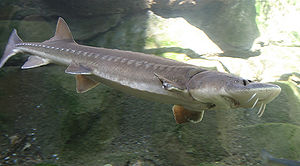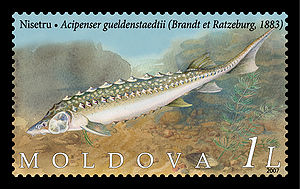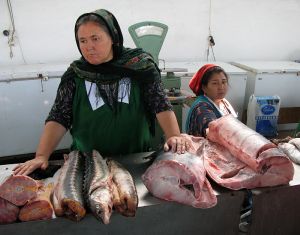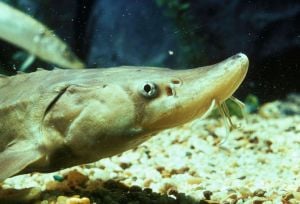Sturgeon
| Sturgeon
| ||||||||||
|---|---|---|---|---|---|---|---|---|---|---|
 Atlantic sturgeon
(Acipenser oxyrinchus oxyrinchus) | ||||||||||
| Scientific classification | ||||||||||
| ||||||||||
|
Acipenserinae |
Sturgeon is the common name for any of the anadromous and freshwater fish comprising the family Acipenseridae of the Order Acipenseriformes of the Class Actinopterygii, characterized by an elongated body, largely cartilaginous skeleton, rows of bony scutes or plates on the body, four barbels in front of the mouth, and protrusible mouth. The term also is used more generally for any members of the Order Acipenseriformes, a group that also includes the paddlefishes (family Polyodontidae) or more exclusively to refer to the species in the two best-known genera, Acipenser and Huso. Some species reach great size, including up to 18 feet (5.5 meters).
Sturgeons are native to subtropical, temperate, and sub-Arctic rivers, lakes and coastlines of Eurasia and North America. Most sturgeons are anadromous bottom-feeders, spawning upstream and feeding in river deltas and estuaries. While some are entirely freshwater, very few venture into the open ocean beyond near coastal areas.
Acipenseridae is one the oldest families of bony fish in existence and sturgeons are one of the few vertebrate taxa that retains a notochord into adulthood.
Several species of sturgeons are harvested for their roe, which is made into caviar — a luxury food which makes some sturgeons pound for pound the most valuable of all harvested fish. Because they are slow-growing and mature very late in life, they are particularly vulnerable to exploitation and to other threats, including pollution and habitat fragmentation. Most species of sturgeons are currently considered to be at risk of extinction, making them more critically endangered than any other group of species.[2]
Overview and description
Actinopterygii, is a major taxonomic class (or subclass) of fish, known as the "ray-finned fishes," whose diverse number of species includes about half of all known living vertebrates and 96 percent of all fish species. The actinopterygians include the most familiar fish, such as sturgeons, gars, eels, carp, herrings, anchovies, catfishes, goldfishes, piranhas, oarfish, seahorses, bass, cichlids, pickerel, salmon, and trout.
The ray-finned fishes are so called because they possess lepidotrichia or "fin rays," their fins being webs of skin supported by bony or horny spines ("rays"), as opposed to the fleshy, lobed fins characteristic of the Sarcopterygii, which together with the actinopterygians comprise the superclass Osteichthyes, or bony fish.
used for some 26 species of fish in the family Acipenseridae, including the genera Acipenser, Huso, Scaphirhynchus and Pseudoscaphirhynchus. The term includes over 20 species commonly referred to as sturgeon and several closely related species that have distinct common names, notably sterlet, kaluga and beluga. Collectively, the family is also known as the true sturgeons. Sturgeon is sometimes used more exclusively to refer to the species in the two best-known genera, Acipenser and Huso.
- All vertebrates also have a notochord—an internal, flexible, rod-shaped supporting structure—at some point in their life cycle. In higher vertebrates, such as the classes Chondrichthyes (cartilaginous fish), Mammalia (mammals), and Aves (birds), this notochord is typically present only in the embryonic stages, serving a structural role until the cartilaginous or bony vertebrae form and surround the dorsal nerve cord (although the notochord persists in such primitive fish as sturgeons).
From Nelson 2006, order Acipenseriformes = sturgeons. Caudal fin heterocercal; skeleton largely cartilaginous; intestine with spiral valve. gulars absent; fin rays more numerous than their basals; Extant representatives in two fmilies, the fmily acipenseridae (sturgeons) and family polyodontidae (paddlefishes). Family acipenseridae = sturgeons. Anadromous and freshwater; northern hemisphere.
They are distinctive for their elongated bodies, lack of scales, and occasional great size: sturgeons ranging from 7–12 feet (2-3½ m) in length are common, and some species grow up to 18 feet (5.5 m).7–12 feet (2-3½ m) in length are common, and some species grow up to 18 feet (5.5 m).
Along with other members of the subclass Chondrostei, sturgeon are primarily cartilaginous, lack vertebral centra, and are partially covered with bony plates called scutes rather than scales. They also have four barbels—tactile organs that precede their toothless mouth and are dragged along often murky river bottoms. Sturgeon are distinctly and immediately recognizable for their elongated bodies, flattened rostra, distinctive scutes and barbels, and elongated upper tail lobes.
They are primarily benthic feeders. With their projecting, wedge-shaped snouts, they stir up the soft bottom, and use the barbels to detect shells, crustaceans and small fish, on which they feed. Having no teeth, they are unable to seize prey, though larger specimens can swallow very large prey items, including whole salmon.[3]
Sturgeon have been referred to as both the Leviathans and Methuselahs of freshwater fish. They are among the largest fish: some beluga (Huso huso) in the Caspian Sea reportedly attain over 5.5 m (18 ft) and 2000 kg[4] (4400 lbs.) while for kaluga (H. dauricus) in the Amur River, similar lengths and over 1000 kg (2200 lb) weights have been reported.[5] They are also probably the longest-lived of the fishes, some living well over 100 years and attaining sexual maturity at 20 years or more.[6] The combination of slow growth and reproductive rates and the extremely high value placed on mature, egg-bearing females make sturgeon particularly vulnerable to overfishing.
Sturgeons are polyploid; some species have four, eight, or 16 sets of chromosomes.[7]
Range and habitat
Sturgeon range from subtropical to subarctic waters in North America and Eurasia. In North America, they range along the Atlantic coast from the Gulf of Mexico to Newfoundland, including the Great Lakes and the St. Lawrence, Missouri and Mississippi Rivers, as well as along the West Coast in major rivers from California to British Columbia and Sturgeon Lake, Alberta. They occur along the European Atlantic coast, including the Mediterranean basin, in the rivers that flow into the Black, Azov and Caspian Seas (Danube, Dnepr, Volga and Don), the north-flowing rivers of Russia that feed the Arctic Ocean (Ob, Yenisei, Lena, Kolyma), in the rivers of Central Asia (Amu Darya and Syr Darya) and Lake Baikal. In the Pacific Ocean, they are found in the Amur River along the Russian-Chinese border, on Sakhalin island, and in the Yangtze and other rivers in northeast China.[6][8]
Throughout this extensive range, almost all species are highly threatened or vulnerable to extinction due to a combination of habitat destruction, overfishing and pollution.[8]
No species are known to naturally occur south of the equator, though attempts at sturgeon aquaculture are being made in Uruguay, South Africa and other places.[9]
Most species are at least partially anadromous, spawning in fresh water and feeding in nutrient-rich, brackish waters of estuaries or undergoing significant migrations along coastlines. However, some species have evolved purely freshwater existences, such as the lake sturgeon (Acipenser fulvescens) and the Baikal sturgeon (A. baerii baicalensis), or have been forced into them by anthropogenic or natural impoundment of their native rivers, as in the case of some subpopulations of white sturgeon (A. transmontanus) in the Columbia River[10] and Siberian sturgeon (A. baerii) in the Ob basin.[11]
Evolution
Acipenseriform fishes appeared in the fossil record approximately 200 million years ago, around the very end of the Triassic, making them among the most ancient of actinopterygian fishes. True sturgeons appear in the fossil record during the Upper Cretaceous. In that time, sturgeons have undergone remarkably little morphological change, indicating their evolution has been exceptionally slow and earning them informal status as living fossils.[12][13] This is explained in part by the long generation interval, tolerance for wide ranges of temperature and salinity, lack of predators due to size, and the abundance of prey items in the benthic environment.
Despite the existence of a fossil record, full classification and phylogeny of the sturgeon species has been difficult to determine, in part due to the high individual and ontogenic variation, including geographical clines in certain features, such as rostrum shape, number of scutes and body length. A further confounding factor is the peculiar ability of sturgeons to produce reproductively viable hybrids, even between species assigned to different genera. The wide range of the acipenserids and their endangered status have made collection of systematic materials difficult. These factors have led researchers in the past to identify over 40 additional species that were rejected by later workers.[14] It is still unclear whether the species in the Acipenser and Huso genera are monophyletic (descended from one ancestor) or paraphyletic (descended from many ancestors)—though it is clear that the morphologically motivated division between these two genera is not supported by the genetic evidence. There is an ongoing effort to resolve the taxonomic confusion using a continuing synthesis of systematic data and molecular techniques.[13][15]
Conservation status
Because of their long reproductive cycles, long migrations, and sensitivity to environmental conditions, many species are under severe threat from overfishing,[16] poaching, water pollution and damming of rivers.[17] According to the IUCN, over 85% of sturgeon species are classified as at risk of extinction, making them more critically endangered than any other group of species.[2][18]
Most species of sturgeons are currently considered to be at risk of extinction, making them more critically endangered than any other group of species.[2]
Uses
Globally, sturgeon fisheries are of great value, primarily as a source for caviar, but also for flesh.
Before 1800, swim bladders of sturgeon (primarily Beluga sturgeon from Russia) were used as a source of isinglass, a form of collagen used historically for the clarification of beer, as a predecessor for gelatin, and to preserve parchments.[19]
The Jewish law of kashrut, which only permits the consumption of fish with scales, forbids sturgeon, as they have ganoid scales instead of the permitted ctenoid and cycloid scales. While all Orthodox groups forbid the consumption of sturgeon, some conservative groups do allow it.[20][21] The theological debate over its kosher status can be traced back to such 19th-century reformers as Aron Chorin, though its consumption was already common in European Jewish communities.[22] It remains a high-end staple of many Jewish delis and specialty shops.
In England, the sturgeon, along with whales and porpoises, is a royal fish, and every sturgeon caught in England is the property of the Crown.
Species
In currently accepted taxonomy, the family Acipenseridae is subdivided into two subfamilies, Acipenserinae, including the genera Acipenser and Huso, and Scaphirhynchinae, including the genera Scaphirhynchus and Pseudosaphirhynchus.[8]
- Family Acipenseridae Bonaparte, 1831
- Subfamily Acipenserinae
- Genus Acipenser Linnaeus, 1758
- Acipenser baerii J. F. Brandt, 1869
- Acipenser baerii baerii J. F. Brandt, 1869 (Siberian sturgeon)
- Acipenser baerii baicalensis Nikolskii, 1896 (Baikal sturgeon)
- Acipenser brevirostrum Lesueur, 1818 (Shortnose sturgeon)
- Acipenser colchicus Marti, 1940 (Black Sea sturgeon)
- Acipenser dabryanus A. H. A. Duméril, 1869 (Yangtze sturgeon)
- Acipenser fulvescens Rafinesque (Lake sturgeon)
- Acipenser gueldenstaedtii J. F. Brandt & Ratzeburg, 1833 (Russian sturgeon)
- Acipenser medirostris Ayres, 1854 (Green sturgeon)
- Acipenser mikadoi Hilgendorf, 1892 (Sakhalin sturgeon)
- Acipenser multiscutatus S. Tanaka (I), 1908 (Japanese sturgeon)
- Acipenser naccarii Bonaparte, 1836 (Adriatic sturgeon)
- Acipenser nudiventris Lovetsky, 1828 (Fringebarbel sturgeon)
- Acipenser oxyrinchus Mitchill, 1815
- Acipenser oxyrinchus desotoi Vladykov, 1955 (Gulf sturgeon)
- Acipenser oxyrinchus oxyrinchus Mitchill, 1815 (Atlantic sturgeon)
- Acipenser persicus Borodin, 1897 (Persian sturgeon)
- Acipenser ruthenus Linnaeus, 1758 (Sterlet)
- Acipenser schrenckii J. F. Brandt, 1869 (Amur sturgeon)
- Acipenser sinensis J. E. Gray, 1835 (Chinese sturgeon)
- Acipenser stellatus Pallas, 1771 (Starry sturgeon)
- Acipenser sturio Linnaeus, 1758 (European sturgeon)
- Acipenser transmontanus J. Richardson, 1836 (White sturgeon)
- Acipenser baerii J. F. Brandt, 1869
- Genus Huso J. F. Brandt & Ratzeburg, 1833
- Huso dauricus (Georgi, 1775) (Kaluga sturgeon)
- Huso huso (Linnaeus, 1758) (Beluga sturgeon)
- Genus Acipenser Linnaeus, 1758
- Subfamily Scaphirhynchinae
- Genus Scaphirhynchus Heckel, 1835
- Scaphirhynchus albus (Forbes & R. E. Richardson, 1905) (Pallid sturgeon)
- Scaphirhynchus platorynchus (Rafinesque, 1820) (Shovelnose sturgeon)
- Scaphirhynchus suttkusi J. D. Williams & Clemmer, 1991 (Alabama sturgeon)
- Genus Pseudoscaphirhynchus Nikolskii, 1900
- Pseudoscaphirhynchus fedtschenkoi (Kessler, 1872) (Syr Darya sturgeon)
- Pseudoscaphirhynchus hermanni (Kessler, 1877) (Dwarf sturgeon)
- Pseudoscaphirhynchus kaufmanni (Kessler, 1877) (Amu Darya sturgeon)
- Genus Scaphirhynchus Heckel, 1835
- Subfamily Acipenserinae
ReferencesISBN links support NWE through referral fees
- ↑ R. Froese and D. Pauly, eds., Acipenseridae, Fishbase (2009)
- ↑ 2.0 2.1 2.2 Sturgeon more critically endangered than any other group of species. IUCN, the International Union for Conservation of Nature (18 March 2010). Retrieved December 6, 2010.
- ↑ Sergei F. Zolotukhin and Nina F. Kaplanova. (2007) Injuries of Salmon in the Amur River and its Estuary as an Index of the Adult Fish Mortality in the Period of Sea Migrations. NPAFC Technical Report No. 4. [1]
- ↑ Frimodt, C., (1995). Multilingual illustrated guide to the world's commercial coldwater fish. Fishing News Books, Osney Mead, Oxford, England. 215 p.
- ↑ Krykhtin, M.L. and V.G. Svirskii (1997). Endemic sturgeons of the Amur River: kaluga, Huso dauricus, and Amur sturgeon, Acipenser schrenckii. Environ. Biol. Fish. 48(1/4):231-239.
- ↑ 6.0 6.1 Berg, L.S. (1962). Freshwater fishes of the U.S.S.R. and adjacent countries. volume 1, 4th edition. Israel Program for Scientific Translations Ltd, Jerusalem. (Russian version published 1948).
- ↑ Anderson, Rachel (2004). Shortnose Sturgeon. McGill University. Archived from the original on 2007-10-24. Retrieved 2007-08-23.
- ↑ 8.0 8.1 8.2 "Acipenseriformes". FishBase. Ed. Ranier Froese and Daniel Pauly. 12 2007 version. N.p.: FishBase, 2007.
- ↑ LA. Burtzev (1999) The History of Global Sturgeon Aquaculture. Journal of Applied Ichthyology 15 (4-5), 325–325. Digital object identifier (DOI): 10.1111/j.1439-0426.1999.tb00336.x
- ↑ S. Duke, P. Anders, G. Ennis, R. Hallock, J. Hammond, S. Ireland, J. Laufle, R. Lauzier, L. Lockhard, B. Marotz, V.L. Paragamian, R. Westerhof (1999) Recovery plan for Kootenai River white sturgeon (Acipenser transmontanus), Journal of Applied Ichthyology 15 (4-5), 157–163.
- ↑ G.I. Ruban, 1999. The Siberian Sturgeon Acipenser baerii Brandt: Structure and Ecology of the Species, Moscow, GEOS. 235 pp (in Russian).
- ↑ B. G. Gardiner (1984) Sturgeons as living fossils. Pp. 148–152 in N. Eldredge and S.M. Stanley, eds. Living fossils. Springer-Verlag, New York.
- ↑ 13.0 13.1 J. Krieger and P.A. Fuerst. (2002) Evidence for a Slowed Rate of Molecular Evolution in the Order Acipenseriformes Molecular Biology and Evolution 19:891-897.
- ↑ W. E. Bemis, E. K. Findeis, and L. Grande. (1997). An overview of Acipenseriformes. Environmental Biology of Fishes 48:25–71.
- ↑ F. Fontana, J. Tagliavini, L. Congiu (2001) Sturgeon genetics and cytogenetics: recent advancements and perspectives. Genetica 111: 359–373
- ↑ Clover, Charles. 2004. The End of the Line: How overfishing is changing the world and what we eat. Ebury Press, London. ISBN 0-09-189780-7
- ↑ Pallid Sturgeon - Montana Fish, Wildlife and Parks
- ↑ Species, status and population trend of Sturgeon on the IUCN Red List of Threatened Species (pdf)
- ↑ Davidson, Alan (1999). ""Isinglass"", Oxford Companion to Food, 407. ISBN 0-19-211579-0.
- ↑ http://cor.ca/en/15#12
- ↑ http://www.bluethread.com/kashrut/sturgeon.html
- ↑ Lupovich, Howard (2010). "7", Jews and Judaism in World History, 258. ISBN 0-203-86197-3.
This article incorporates text from the Encyclopædia Britannica Eleventh Edition, a publication now in the public domain.
- Nelson, J. S. 2006. Fishes of the World, 4th edition. Hoboken, NJ: John Wiley & Sons. ISBN 0471250317.
External links
- FishBase info on Acipenser
- Official Website of the World Sturgeon Conservation Society
- Sturgeon feeding on the remains of a fish at Eccleston Delph, Lancashire England – Set of images on Flickr
Template:Commercial fish topics Template:Acipenseriformes
Credits
New World Encyclopedia writers and editors rewrote and completed the Wikipedia article in accordance with New World Encyclopedia standards. This article abides by terms of the Creative Commons CC-by-sa 3.0 License (CC-by-sa), which may be used and disseminated with proper attribution. Credit is due under the terms of this license that can reference both the New World Encyclopedia contributors and the selfless volunteer contributors of the Wikimedia Foundation. To cite this article click here for a list of acceptable citing formats.The history of earlier contributions by wikipedians is accessible to researchers here:
The history of this article since it was imported to New World Encyclopedia:
Note: Some restrictions may apply to use of individual images which are separately licensed.



